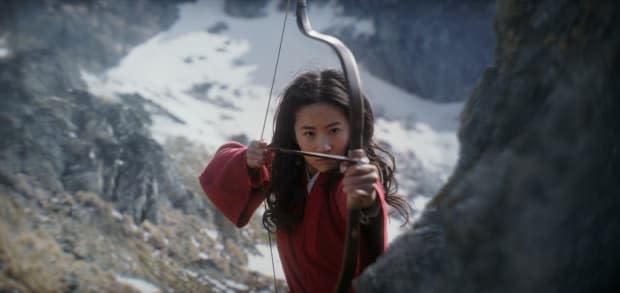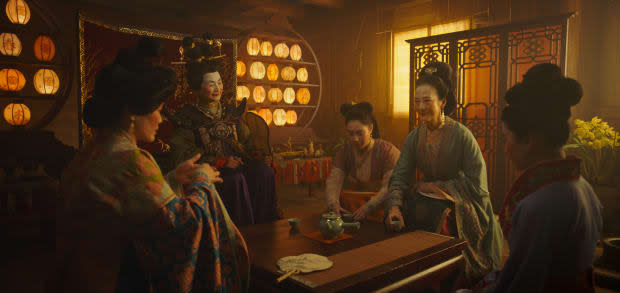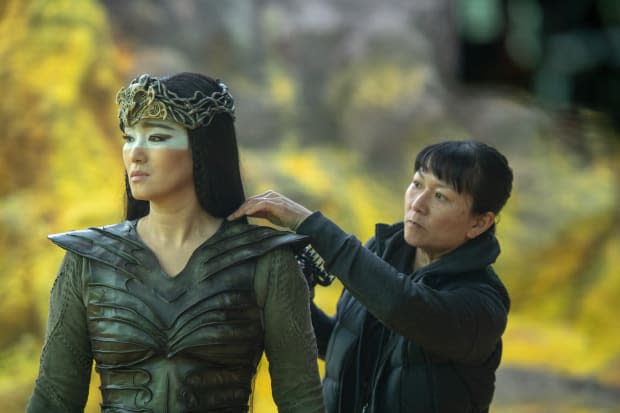How the Makeup, Hair and Costumes in 'Mulan' Speak to Chinese Art and History — and Disney Nostalgia
After a few Covid-19 related delays, the live-action "Mulan" finally premieres in the U.S. today, but in an unprecedented format: via streaming on Disney +.
Like the beloved 1998 animated hit, the sweeping update, directed by New Zealander Niki Caro, takes place in the Northern Wei territories in the Tang Dynasty (circa 620 A.D.). This time around, the legend is presented as a grittier war epic with an all-Asian cast and female director — without the beloved songs (or a dragon sidekick named after a popular Chinese-American dish). You know the story: To save her father from conscription, Mulan disguises herself as a man to take his place in the Northern army as they head to battle with the South.
In May, Caro wrote on Instagram that her vision is "to honor the Disney culture, as well as honoring the Chinese culture." "Mulan," the only Disney heroine of East Asian descent, is a big deal to Asian Americans, too — for many, the '90s film was one of the first times they saw someone who looked like themselves reflected (sorry) back on-screen, leading a big budget movie, even if it was in animated form. So, with the help of hair and makeup design by Denise Kum and costumes by Bina Daigeler, the much-anticipated live-action "Mulan" aims to both represent Chinese culture and bring the Disney nostalgia — a tall order.

For New Zealand-born Kum, who is of Chinese descent, re-teaming with Caro for a sixth time held even deeper meaning. "The 'Ballad of Mulan' is culturally significant from childhood," says Kum, over the phone. "It was really interesting for me to be able to delve into it deeper as a designer and as part of the filmmaking effort."
For research prep, German costume designer Daigeler — who recently received an Emmy nomination for her costume design of "Mrs. America" — spent three weeks in Mainland China studying art and history in museums in Shanghai, Beijing and Xi'an, the ancient capital of the Tang Dynasty. She amassed a research library, plus visited Chinese exhibits in museums in London and Europe, as she told Variety at the Los Angeles premiere party in March (which elicited some comments).
"I wanted to treat it very respectfully, the Chinese history, but of course, at the end, I made my own recipe of it and I recreated this fantasy [out of] what I learned during my research time," explains Daigeler, on a call in March.
Related Articles:
The 'Awkafina is Nora From Queens' Costumes Include a Sandy Liang Congee Village T and Derek Lam Joggers
The 5 Most LOL (and Heartfelt Cry) Costume Moments in Mindy Kaling's 'Never Have I Ever'
The Fabulous Costumes of 'Crazy Rich Asians' Are Stacked With Dolce & Gabbana, Valentino and Lots of Asian Designers
Kum, who was prepping wigs and hairpieces for the entire cast in New Zealand (and flying to Singapore to fit cinema legend Jet Li, who plays the Emperor), couldn't make the China trip. But she studied up on dynastic history, plus art and literature of the Tang and surrounding dynasties. She also consulted cultural advisors that Disney had on staff for historical authenticity and creative ideas about mixing period details. She even checked with the military advisor on how soldiers' helmets would affect the hairstyles of the period. "It was quite collaborative in that way to really spend a lot of time to do the research in order to inform a decision," she explains.
When asked if she consulted with local advisors on the costumes, Daigeler says she did not. "I based a lot on my intuition. A lot. I walked through a new city and I suddenly insist, 'Oh, I want to go there!" she says. "It happened in Shanghai. My Chinese assistant said, 'Why do you want to go there? It's not interesting.' I said, 'Let's go there' and I found three amazing pieces that were exactly what I wanted for a costume. I'm very much guided by my intuition."

For her disastrous visit to the matchmaker, Mulan (Liu Yifei) dons a full face of betrothal makeup, which speaks to the animation and Tang Dynasty beauty ideals. (Plus, the look went viral in Mainland China last year, with hashtags like #MulanMakeupImitation, and garnered over 300 million social media views.) Kum studied sculptures and read up on literature (think stories about the king's favorite concubines) to glean social conventions and "ideas of beauty" about that era. She illustrated the seven layers of makeup technique, which is depicted in the film as Mulan's mother Li (Rosalind Chao) applies the pigments with proper tools.
Mulan's yellow gold forehead and red rouged cheeks symbolize auspiciousness and good luck. The final application is the forehead "hua dian," or the decorative detail, which in Mulan's case is a three-petal plum blossom, which originated from a legend from the Southern Dynasty. "[Princess Shouyang] had taken a walk in the palace and a plum blossom fell on her forehead and for some reason could not be washed off or removed. Fortunately it looked beautiful on her and it became a trend [in the Tang and Song Dynasties]," explains Kum.
Of course, the pigments are heightened for the movie — more importantly, a Disney movie. "I used primary colors that are very symbolic in Chinese colors, but at the same time they're very seminal in old-school Disney," says Kum, referencing Mickey Mouse's and Donald Duck's signature hues.

Like Mulan, the Matchmaker (Pei Pei Cheng) also wears the saturated rouge, running from the temple to cheek, which is referred to as "red clouds at dawn." "It's associated with an old story of a female musician at a palace, who touches her face and leaves a mark, like, 'a red cloud at dawn," says Kum, who also enjoyed referencing Tang Dynasty figurines, like ones her mother had in the home growing up.
For a comedic element, she gave the Matchmaker more exaggerated makeup and a crescent moon hua dian for a look that many of us in the diaspora know all too well. "Little kids in the audience, [may recognize] an overbearing puo puo or an old Chinese grandma," Kum notes.
Everyone's sculptural hair, overdecorated with ornaments, speaks to both the heightened elements of the scene, but also real trends of the time: "People, when they were trying to be more of a couture look, as opposed to a village look, would pile their hair up and had lots of false buns and false hair pieces," Kum explains. She also decorated the wigs with hand-made, custom-designed jewelry from Daigeler's artisan team.
Mulan's elaborate robe ensemble in purple harks back to her palette in the animated classic. But Daigeler brought the iconic look to live-action through a hanfu, the traditional pre-17th century Han-majority Chinese dress, which is back en vogue in Mainland China after falling out of favor in the Qing Dynasty (1644 – 1912). The multiple layers of the robe, underdress, panel and the sash allowed for "a lot of possibilities" for filming the dramatic "twirling" scene.
The Chinese embroidery, done by London-based Cathryn Avison, includes the running magnolia theme, plus dragons and butterflies. "Because she's a very spirited warrior and girl," says Daigeler. Building Mulan's hanfu took nearly four weeks of embroidering nearly 40 feet of material. Plus, three multiples were needed for the acrobatic stunts with the tea set. "It was a very, very long process," she adds.

When Mulan sneaks off to join the army, she takes the family sword and leaves her magnolia jeweled comb, based off the animation and made by a specialty jeweler in New Zealand. ("Hua Mulan" translates directly as "magnolia flower," which is a motif seen throughout the film.) But the embroidery on the lapel of her red warrior robe features a new theme: clouds, which Daigeler found in her dynastic research.
"We were all very happy because it gave more deepness and texture to her warrior tunic," says Daigeler. (She incorporated the shapes into Mulan's army outfit and armor, too.)
Because Mulan is disguising herself in battle gear worn by men, Daigeler designed the armor and uniforms for Mulan's fellow male soldiers first. Kum also gave each of the uniformed soldiers — or Mulan's "squad" — little grooming quirks, like the peach fuzz on Po (Doua Moua, below) for personality and differentiation.

The cord and plaque armor — small iron plates bonded together with strips of fabric — dates back to the preceding Sui Dynasty (589 to 618 A.D.). But actual metal wouldn't allow for the balletic battle showdowns that Caro envisioned.
"Niki was looking for a very spirited and stylish action scene — more like tai chi movements — so I really wanted to have an armor that moves with Yifei, when she does all her flips and turns and jumps and everything," says Daigeler.
The armor also had to be flexible and versatile for Mulan to effortlessly strip away modular components for the climactic battle scenes. During her moment of realization before revealing her true self on the battlefield, she effortlessly dismantles the full-body protective tunic into a skirt-silhouette to "reveal the strong, female body," per Caro's Instagram. So Daigeler worked with leather artisans in New Zealand to develop a lightweight hand-stitched technique that mimics metal.
Mulan also removes her helmet to reveal her long, flowing hair (which Twitter noted looked maybe a little too good after roughing it in army training). Kum is proud of her team's reliance on "old school, physical effects," in lieu of VFX and CG, especially for Mulan's "this is me, woman warrior, hear me roar" moment.
"There's strategically-placed pins and there's something called fishing line," laughs Kum, who also credits that her team, including Georgia Lockhart-Adams, for testing and practicing different scenarios with Liu. "Yifei was so great like that," she adds.

The movie features Chinese legends of international cinema including Li Gong as Xian Lang, a witch with shapeshifting abilities. To do Li and the character justice, Kum emphasizes a collaboration with Daigeler on "the architecture of her whole look."
"For us, it was important that she is very, very powerful and very strong," says Daigeler. Inspired by the hawk, she used "natural, earthy" textures and hues in the sculpted leather costume, also made in the light-weight technique. Xian Lang's intricate crown also speaks to the earthy-theme, she adds: "I looked up a lot of skeletons and earthy animal inspirations."
Kum studied paintings from 960 to 1300 A.D. — especially by Tang court artist Zhou Fang, known for his "The Beautiful Women" genre of painting with the white pigment painted faces. Kum also mixed in the concept of the white "suspicious" character mask from Beijing Opera, which originated in the mid-Qing Dynasty, plus modern fashion influences.
"There was a great Alexander McQueen reference that Bina had shown me and that Li Gong really liked," says Kum, about the melange of influences resulting in the airbrushed white mask concept.
She also matched the rest of the makeup and hair design to the elaborate hawk-inspired costume: "I started thinking of feathers and the shapes in her eye makeup, and also the colors that we used — tawny hues, graphites." She coordinated Xian Lang's side-braids with the leather binding and stitching on her corset and the framing of the crown.
"We wanted her to be a little bit other worldly, with almost fantasy element," says Kum. "But also rooted in a lot of the same Chinese heritage."
Never miss the latest fashion industry news. Sign up for the Fashionista daily newsletter.

 Yahoo News
Yahoo News 